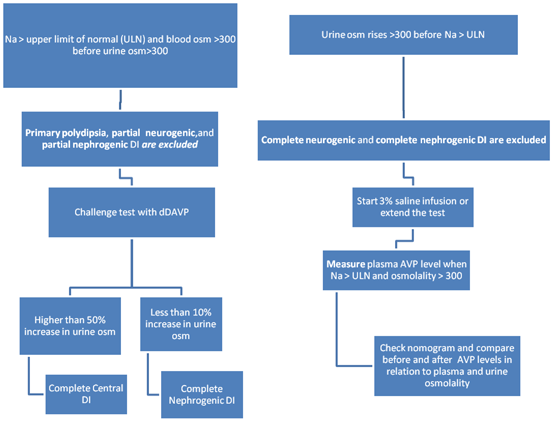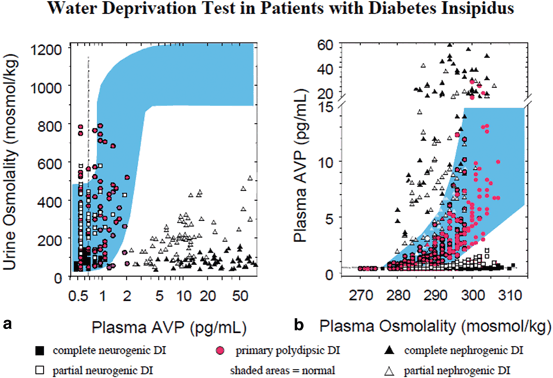Precautions:
Severe dehydration (hypotension, tachycardia) may occur in patients with true diabetes insipidus. Weight loss should not be allowed to exceed 5 % of initial body weight and blood pressure should be monitored closely. Do not perform the water deprivation test in patients with renal insufficiency, uncontrolled diabetes mellitus, hypovolemia of any cause, untreated adrenal insufficiency, and hypothyroidism.
Interpretation:
Normal response: Urine osmolality > 600 mOsm/kg.
1.
If serum osmolality goes above 300 mOsm/kg or serum sodium goes above (upper limit of normal) ULN while urine osmolality is less than 300 mOsm/kg primary polydipsia, partial neurogenic, and partial nephrogenic DI are excluded, and a challenge test with dDAVP 2 mcg SC is required.
2.
If urine osmolality rises above 300 mOsm/kg before serum sodium is above the upper limit of normal; complete neurogenic and complete nephrogenic DI are excluded. Start 3 % saline infusion or extend the test if 3 % saline infusion is not possible. Once serum sodium or osmolality goal is achieved, draw blood for plasma AVP level and serum osmolality, and then administer DDAVP to see the response to DDAVP. See Figs. 18.1 and 18.2.



Fig. 18.1
Diagnostic algorithm for diabetes insipidus during water deprivation test

Fig. 18.2
Results of the water deprivation test on normal subjects (shaded areas) and patients with the three major forms of diabetes insipidus. Each plotted symbol represents a simultaneous sampling for two variables: plasma AVP (the antidiuretic hormone, arginine vasopressin) and urine osmolality (Fig. 18.1a), and plasma osmolality and plasma AVP (Fig. 18.1b). The interrupted lines denote the limit of the assay for plasma AVP; below the limiting value, no AVP can be detected in the plasma. (The data come from patients seen by Dr. Gary L. Robertson) [3]
Caveats:
1. In most patients, differentiation between different etiologies of DI may be reached by careful review of medical history and prior work up without a need for performing water deprivation test.
Stay updated, free articles. Join our Telegram channel

Full access? Get Clinical Tree



